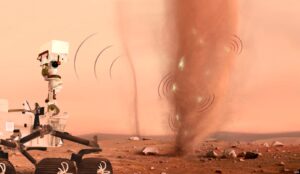Soutenance de thèse
Rémi Gaillard
LGENS
Representation and analysis of climate-carbon-nitrogen interactions over permafrost regions in the IPSL Earth system model
Résumé
Permafrost soils, found in cold regions of the globe, contain large amounts of organic carbon. These carbon stocks are threatened by the strong Arctic warming, which causes permafrost to thaw, exposing previously frozen organic matter to decomposition. This results in CO2 and CH4 emissions that amplify global warming through the so-called permafrost carbon-climate feedback, with implications for carbon budgets and emission reduction pathways. However, both the timing and magnitude of this feedback remain highly uncertain. In fact, the future dynamics of the permafrost carbon cycle have only been assessed using land surface models (LSMs) or models of intermediate complexity, with contrasting responses.
Among the models of the Coupled Model Intercomparison Project Phase 6 (CMIP6), launched in 2014 to better understand the responses of climate system to anthropogenic forcings, only two Earth System Models (ESMs) include permafrost carbon, and both share the same land component. This thesis sheds new light on the subject by incorporating permafrost mechanisms into another ESM.
As part of my thesis, I developed a new Earth system model, called IPSL-Perm-LandN, building on physical and biogeochemical permafrost processes originally developed at the Institut Pierre-Simon Laplace (IPSL) in the early 2010s. This involved incorporating additional features, such as soil insulation by groundcover, into a version of the land surface model that already included an explicit representation of the land nitrogen cycle.
As a first step towards improving the realism of the representation of the Arctic climate, the latent heat of soil water phase change and soil insulation by soil organic carbon and a surface organic layer (i.e. mosses, lichens, litter) are shown to strongly influence the surface air temperature and snowfall fraction. Their inclusion in the model leads to an improvement of the high-latitude climate simulations and of the thermal state of permafrost, which is consistent with observations and satellite products. IPSL-Perm-LandN is evaluated against observations and data-driven products over the historical period (1850-2014) and consistently simulates much larger permafrost soil carbon stocks than the previous version of the IPSL ESM. The permafrost region is found to be a net carbon sink in recent decades with a net land-atmosphere carbon flux consistent with the upscaling of flux measurements.
Under future increasing atmospheric CO2 concentrations, the permafrost region remains a carbon sink in IPSL-Perm-LandN despite significant soil carbon losses caused by permafrost thaw, due to counteracting negative feedbacks. In particular, the increased nitrogen availability following permafrost thaw is found to reduce vegetation nitrogen limitation and thus to increase land carbon uptake, although this effect is likely to be overestimated. Finally, the model simulates irreversible land and ocean carbon changes under atmospheric CO2 overshoot pathways. In aggressive mitigation scenarios, land and ocean turn into carbon sources, partially offsetting mitigation efforts and highlighting the need to minimise temperature overshoots as much as possible.
Informations supplémentaires
Lieu
École normale supérieure – PSL
24 rue Lhomond – aile Erasme
Salle Claude Froidevaux – E314
Visio
https://cnrs.zoom.us/j/98529346904?pwd=ajI1mIrt1hpltjsg88uEDt8CrbRbzm.1
Composition du jury
- Florence Habets (examinatrice) – Directrice de recherche CNRS à l’Ecole Normale Supérieure
- Christina Biasi (rapportrice) – Directrice de recherche à l’université d’Eastern Finland
- Bertrand Decharme (rapporteur) – Directeur de recherche CNRS
- Sönke Zaehle (examinateur) – Professeur au Max Plank Intitute for Biogeochemistry
- Chris Jones (examinateur) – Professeur à l’université de Bristol
- Bertrand Guenet (directeur de thèse) – Chargé de recherche CNRS à l’École Normale Supérieure
- Patricia Cadule (co-directrice) – Ingénieure de recherche CNRS à l’Institut Pierre-Simon Laplace
- Philippe Peylin (co-encadrant) – Directeur de recherche CNRS au Laboratoire des sciences du climat et de l’environnement





